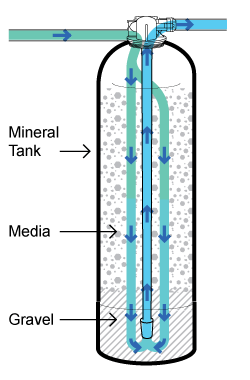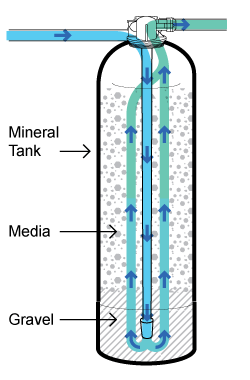How Upflow (In/Out) Whole House Water Filters Work

Simple point of entry (whole house) water filters that do not backwash to clean and resettle their filter media are often called "in/out" filters. The water simply goes in one side, passes through the filter media, then goes out the other side. There's nothing fancy about this type filter. It's a big tank called a mineral tank that is filled with granular filter media. It has a simple center tube called a "riser" to direct the flow of water inside the tank.
The filter pictured above is the most common style, the downflow. Water enters the tank head from the left, is released into the top of the tank, and works its way through the media to the bottom of the tank. At the very bottom of the tank the water passes through the fine slots in the riser basket, then is forced upward through the riser to the tank head and exits the filter at right.
The Upflow Version:

In the upflow version of the same filter, water enters the tank head and is sent down the riser tube to be released at the bottom of the tank. It slowly works its way upward through the media and is collected at the top and exits the filter.
In/Out filters are inexpensive as compared with backwashing filters. Their simplicity also makes them attractive alternatives to backwashing filters in many situations. Their use is limited, however, mainly to use as dechlorinating filters for city water and for neutralizing filters for acidic well water. Plus, the water they treat must be clean, so it's wise to always install a sediment filter in front of an in/out filter.
In/Out filters do not work as iron filters, because a backwash function is needed to get rid of the trapped iron. Likewise, they do not work as sediment filters and must, as noted, be protected from sediment when they are used as city water dechlorinating filters or as neutralizing filters for wells.
In/Put filters actually have an advantage over backwashing filters for city water dechlorination in that more media can be loaded in the tank since freeboard space does not have to be left at the top of the tank to accommodate backwashing. For example, a 10" X 54" backwashing filter can be loaded with 1.5 cubic feet of carbon, but a 2.0 cubic foot bed works well in an In/Out filter.
In most filter designs, with simple filters like those shown on this page a downflow filter can be installed as an upflow filter simply by reversing the direction of flow into the tank.
More about In/Out Upflow Filters.